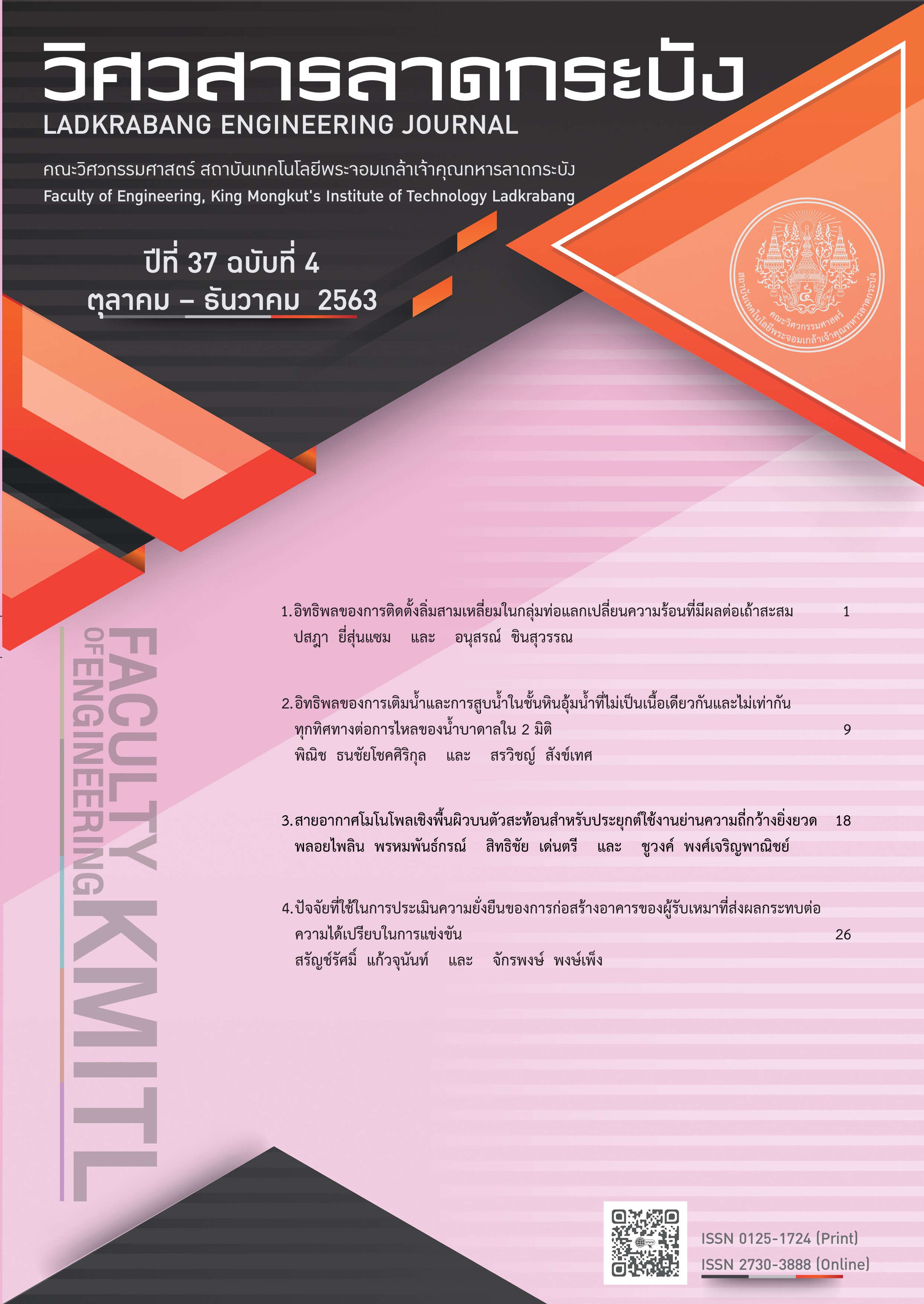อิทธิพลของการติดตั้งลิ่มสามเหลี่ยมในกลุ่มท่อแลกเปลี่ยนความร้อนที่มีผลต่อเถ้าสะสม
คำสำคัญ:
เถ้าลอยสะสม, กลุ่มท่อแลกเปลี่ยนความร้อน, ลิ่ม, เถ้าสะสมบทคัดย่อ
การศึกษานี้มีวัตถุประสงค์เพื่อตรวจสอบผลของการไหลตามขวางเนื่องจากลิ่มหน้าตัดรูปสามเหลี่ยมที่สอดเข้าไปในกลุ่มท่อ การทดลองดำเนินการในกลุ่มท่อ 6 แถว 3 คอลัมน์ โดยความสูงของลิ่มมีขนาดเท่ากัน ต่างกันที่มุมยอดของลิ่ม สี่ขนาด คือ 3.58, 7.125, 14.036 และ 26.36 องศา ทำการทดลองที่ความเร็วอากาศคงที่และความเข้มข้นของเถ้าเท่ากับ 2.1 m/s และ 0.00365 kg/s ตามลำดับ โดยตำแหน่งการวางลิ่มจากระยะปากทางเกลุ่มท่อเท่ากับ 7.1%, 29%, 57% และ 86% ของระยะความยาวกลุ่มท่อทั้งหมด พบว่าลิ่มไม่เพียงทำให้ ความเร็วในการไหลเพิ่มเท่านั้น แต่ยังทำให้ทิศทางการไหลเปลี่ยนไปด้วย เป็นผลให้การสะสมเถ้าที่ท่อลดลง ผลกระทบนี้จะเพิ่มขึ้นตามมุมยอดของลิ่ม นอกจากนี้การสะสมเถ้าจะต่ำที่สุดเมื่อลิ่มติดตั้งอยู่ที่ระยะ 29% ของระยะความยาวกลุ่มท่อทั้งหมด
References
K. Walawiak, S. Kalisz, “Using fluent code to predic deposit during combustion of solid fuels”. Proceedings of International Conference on Heat Exchanger Fouling and Cleaning . Crete Island. Greece, Jun, 2011.
M.S. Abd-Elhady, C. C. M. Rindt, J. G. Wijers, A. A. Steenhoven, “Modelling the Impaction of a Micron Particle with a Powdery Layer,” Powder Technology, Vol.168, pp.111-124, Oct, 2006.
D. Bouris, G. Papadakis, G. Bergeles, “Numerical Evaluation of Alternate Tube Configurations for Particle Deposition Rate Reduction in Heat Exchanger Tube Bundles”, International Journal of Heat and Fluid Flow, pp.525-536, Oct, 2001.
D. Bouris, E. Konstantinidis, S. Balabani, D. Castiglia, and G. Bergeles, “Design of a Novel, Intensified Heat Exchanger for Reduced Fouling Rates,” International Journal of Heat and Mass Transfer, Vol.48, pp.3817-3832, Aug, 2005.
M.S. Abd-Elhady, C.C.M. Rindt, J.G. Wijers, A.A. van Steenhoven, E.A. Bramer, T.van der Meer, “Minimum gas speed in heat exchangers to avoid particulate fouling,” International Journal of Heat and Mass Transfer, Vol.47 pp.3943–3955, Aug, 2004.
M.J. Li, S.Z. Tang, F. Wang, Q.X. Zhao, W.Q. Tao, “Gas-side fouling erosion and corrosion of heat exchangers for middle/low temperature waste heat utilization: A review on simulation and experiment,” Applied Thermal Engineering, Vol.126, pp.737–761, Nov, 2017.
B. Kilkovský, V. Turek, Z Jegla, P. Stehlík, “Aspects of Fouling in Case of Heat Exchangers with Pollutes Gas,” International Conference on Heat Transfer, Fluid Mechanics and Thermodynamics, Pointe Aux Piments. Mauritius, Jul, 2011.
M.C. Vanbeek, “Gas-side fouling in heat recovery boilers,” Degree of Doctor of Philosophy Thesis, Eindhoven University of technology , Eindhoven, Netherlands, 2001.
M. George A. Hawkins Jakob, “Elements of Heat Transfer, John Wiley & Sons, 1957.
M.N. Özışık, “Heat Transfer: A Basic Approach, McGraw-Hill, 1985.
P. Incropera, P. Dewitt “ Introduction to Heat Transfer, John Wiley & Sons, 1985.
M.S. Abd-Elhady, M.R. Malayeri, “Asymptotic characteristics of particulate deposit formation in exhaust gas recirculation (EGR) coolers,” Applied Thermal Engineering, Vol.60, pp.96–104. Oct, 2013.
P. Yisunzam, A. Chinsuwan, Effect of transverse triangular cross-sectional wedges on the asymptotic fouling deposition behavior of the flow through an inline tube bundle, International journal of heat and mass transfer, In press.
Downloads
เผยแพร่แล้ว
How to Cite
ฉบับ
บท
License
บทความที่ได้รับการตีพิมพ์เป็นลิขสิทธิ์ของคณะวิศวกรรมศาสตร์ สถาบันเทคโนโลยีพระจอมเกล้าเจ้าคุณทหารลาดกระบัง
ข้อความที่ปรากฏในบทความแต่ละเรื่องในวารสารวิชาการเล่มนี้เป็นความคิดเห็นส่วนตัวของผู้เขียนแต่ละท่านไม่เกี่ยวข้องกับสถาบันเทคโนโลยีพระจอมเกล้าเจ้าคุณทหารลาดกระบัง และคณาจารย์ท่านอื่นๆในสถาบันฯ แต่อย่างใด ความรับผิดชอบองค์ประกอบทั้งหมดของบทความแต่ละเรื่องเป็นของผู้เขียนแต่ละท่าน หากมีความผิดพลาดใดๆ ผู้เขียนแต่ละท่านจะรับผิดชอบบทความของตนเองแต่ผู้เดียว






